Presenting Rabbit Island, a film by Ben Moon
In the summer of 2013, filmmakers Ben Moon and Page Stephenson spent a week exploring Rabbit Island. We weren’t yet a non-profit, and we had little money to support visiting artists – but those 90 acres, surrounded by the greatest great lake in the world, had already been legally preserved in perpetuity. Two years later, their film premiered at the Mountainfilm Festival in Telluride, Colorado. Since then, it’s played at more than a dozen acclaimed film festivals, and, with support from Patagonia, been featured on National Geographic Adventure’s website. In 2014 and 2015 Rabbit Island hosted 12 artists from five countries and over that same period received more than four hundred inspired applications from around the world. It all began that summer, and we hope above all else that this film supports the ideology that restraint can be virtue, that doing nothing can equate to doing the most good. Thank you, Ben, for training your eye on this little speck of wilderness defined by three quadrillion gallons of fresh water. May it remain thus forever.
Rabbit Island Film: Text Archive
In July, 2013, Filmmakers Ben Moon and Page Stephenson travelled from Oregon to Rabbit Island to make a short film. They spent a week exploring the island while living alongside eight other artists who were pursing various creative projects. Together Ben and Page shot hours of footage and collected interviews of each artist in a recording studio set up in a small mossy clearing behind the main shelter surrounded by maple trees. Over the next two years this footage and sound percolated through their minds and ultimately became the short film Rabbit Island. Along the way artists Dana Shaw, Israel Nebeker, Lucy Engelman, Emilie Lee, Jessica Kilroy and Skip Armstrong played integral parts in its creation.
The film originally debuted at the 2015 Mountainfilm Festival in Telluride, Colorado, and has since travelled across the country, playing at more than a dozen film festivals. It was released publicly in December, 2015, on the National Geographic Adventure website with generous support from Patagonia.
Here we present a collection of ideas associated with the film intended for our archive. Projects such as this one, after all, leap from the island’s wilderness each year, yet the wilderness remains forever–an example, perhaps, of leave-no-trace-ethics intersecting with artistic practice. It is wonderful to think about, actually. If you are watching this footage hundred of years from now, please note the environmental surroundings and do your best to ensure the Rabbit Island remains as filmed, and that the legal contracts governing its protection remain in force.
2013 was a breakthrough year for our organization. That spring we summoned talented artist friends from across the country via word of mouth and various social media introductions, and hosted 18 individuals over three weeks. Some artists stayed for only a few days while others, such as Lucy Engelman and Eva Dwyer, spent several weeks on the island.
Looking back it is clear that because of these artists and their projects it was possible for Rabbit Island to evolve into a program that now draws diverse conceptual interest from around the globe. Ben was there to document this with grace and style, and this film is so meaningful to us. It captures the launch of a juxtaposition we hold as special. First, there is the idea we hold as timeless–wilderness–and, second, stands the modern conception of creative judgement as it relates to ecology.
2013 also saw the christening of a new surf break along the north point of the island that was formed by a strong blow from Canada. This is pictured briefly in the film. The break, never before seen or surfed, is aptly named the Moon Break, after Ben initiated a paddle out in spite of 40 degree July weather and 55 degree water. The break will be there forever, four miles from the mainland in Lake Superior, whenever there’s a northeast blow.
Ben’s film beautifully communicates the story of a remote environment and encourages others to consider what it means to create something in the context of the environment and the laws of society that govern land use. Hopefully many more people will be compelled to pursue the ideology that restraint can be virtue, that doing nothing to land can symbolize doing the most good. The effect art has on one’s perspective, after all, is the most compelling thing about it. Once created, art is interjected into the cultural conversation and influences its trajectory.
Thank you, Ben, for training your eye on this little speck of wilderness. The persistent application of your creativity to the wider conservation effort is inspiring.
The following was written by Ben regarding the release of his film.
Ben Moon: When I first talked with Rob Gorski, he had told me about how he had chosen to preserve the nearly untouched island habitat, while allowing artists and scientists a place to create and study amidst the unique nature of the place. Having grown up in the Great Lakes, I was eager to see the island and traveled there with Page Stephenson to document what we found there, filming with the other the artists in residence there at the time.
Thank you to Patagonia for supporting the film, Dana Shaw for the edit, Israel Nebeker of Blind Pilot for composing an original score, Skip Armstrong for the colorist magic, Lucy Engelman for the illustrations, Emilie Lee for introducing me to the place, Jessica Kilroy for the field recordings, and to all the artists involved.
Festivals
2015 Telluride Mountainfilm Festival // World Tour
2016 Wild and Scenic Film Festival
2016 Big Sky Documentary Film Festival
2016 DC Environmental Film Festival
2016 Flagstaff Mountain Film Festival
2015 Crested Butte Film Festival
2015 DC Adventure Film Festival
2016 Vancouver International Mountain Film Festival
2015 Made In Michigan Film Festival
2016 Madeline Island Film Series
The following text by Mary Anne Potts was originally published on the National Geographic Adventure blog, December 22, 2015.
On undivided, uninhabited, undeveloped Rabbit Island, described as “a 90-acre speck amidst 3,000,000,000,000,000 gallons of fresh water,” a revolving ensemble of artists is contemplating our modern connection to nature in the Great Lakes country of Michigan. Photographer and climber Ben Moon recently brought his own artist’s eye to the island to create this short film. “My intent was simply to start a conversation with the film—about preserving our backyards to create change and keep pristine spaces to share and inspire others,” notes Moon, whose own story was told in the beloved recent film Denali. “There are no mountains to climb or feats to achieve, there is only time to think about the society you can barely glimpse on the horizon, regardless of what Lake Superior has in store that day,” says Rob Gorski, Rabbit Island’s creative genius and owner. Below Moon and Gorski share how and why Rabbit Island came to be—and it has nothing to do with rabbits.
Ben, we see you in a few frames of the film, surfing and taking a Polaroid. What brought you to tell this story of landscape and art and living wild?
Ben Moon: I first heard about Rabbit Island through my talented artist friend Emilie Lee, and she is who connected me with Rob Gorski. During my first conversation with Rob, I was immediately intrigued by both his description of the place and his philosophies on preserving its wild nature for future generations, while also inspiring the artists who spend time on the island. I traveled to Rabbit Island that summer with a simple intent to document the place, either through photographs or a short film… and this five-minute short was the result of my six-day residency on the island.
Having grown up in the Great Lakes, spending time in the midst of Lake Superior was an incredibly nostalgic and fulfilling experience. I also had the unique opportunity to pioneer an unsurfed point break on the island with Rob, and slipping into those saltless freshwater waves was a surreal experience that I won’t soon forget. After our surf, he named the point Moon Break.
Are there in fact a lot of rabbits on Rabbit Island? Where does the name come from?
Rob Gorski: Nope, no rabbits. At least since the bald eagle family moved back to the island in the 90s, after the Silent Spring era passed. Rabbit Island’s name is a reference to the closest mainland community, Rabbit Bay. The handful of year-round residents historically looked out over the horizon to the east and saw… Rabbit Island.
How do the artists living on the island get food and supplies? Is it a “supported” experience or “unsupported”?
RG: Artists are given a stipend of approximately $1,500 to cover the expenses of their stay, but are responsible for outfitting themselves on the mainland prior to departure. Basic open shelter, a small sauna, cooking supplies, and a library compose the infrastructure of the island. This means different things for different artists. Some arrive with experience in the wilderness and are comfortable fishing and foraging, and wing it a bit with general camp staples. Other artists meticulously plan each individual meal prior to leaving. Some utilize various modern technologies to make work. Occasionally artists will pick a calm day and take a small dingy back to the mainland to resupply. All clothing and materials are up to the artists to provide for themselves. Artists are asked to leave the island as they found it upon completion of their residencies.
Is Rabbit Island going to stay undivided and uninhabited in perpetuity?
RG: Yes, wilderness is the premise of the project and the idea of undivided land and watersheds is our highest priority. Our hope is that beyond the preservation of Rabbit Island, itself but a 90-acre speck amidst 3,000,000,000,000,000 gallons of fresh water, the ideas that are transmitted from the island will define a culture that will carry to the mainland.
One of our favorite sayings is, “The English language does not have an antonym for the word subdivision.” It is strange when you think about it but there isn’t. At least not in the way that we use the word every day. Rabbit Island is trying to change this. Beyond the beauty of the island wilderness, relationships created, adventures had, and art made, there is the intention to draw light to a more lasting idea: Without the foresight to create wilderness it would not be there to be enjoyed. This idea can never stop being reborn.
How does the wilderness aspect impact the art created by the artists?
RG: We’re living in a maker moment. Everybody is making something and DIY is everywhere. Yet this is often where the conversation ends. The typical narrative tells that when you make something and sell it, you are successful. We baulk at this. What is missing from the discussion is the value of the product in more absolute terms relative to the wider environment. Is what is being made adding to or detracting from our larger problems? Is entrepreneurial success being confused with environmental science? When making is considered from this perspective the creation of anything a human mind can think up becomes and ethical decision. Artists, then, the fundamental makers, become symbolic, and the idea of thinking through what you are making from a very wide perspective becomes central. The wilderness is a very good ruler to measure the success of this effort by. This kind of thought is necessary in the context of what we now know about the connectedness of our ecology. We’re excited about an opera that was written on the island this summer by Juilliard-trained composer Eugene Birman about man’s relationship to nature in the modern world. Eugene took his craft and found a subject relevant to the larger cultural narrative. In the end our culture’s ethics are changing relative to what passes as successful creation—and they must! Artists on Rabbit Island forge ahead with this idea in direct terms.
One of the motto’s of the project:
“Wilderness is Civilization.” For so long the wilderness was seen as something to tame for the sake of civilization. Now we see the shortsightedness of this and Rabbit Island argues that the restraint exhibited in keeping a piece of land undeveloped, in spite of all possible development alternatives, is evidence of a civilized perspective in the most contemporary context. Even more than a symphony orchestra or a ballet in New York City! Our wish would be that everyone experienced the feeling of contributing some amount of their personal means to preserving wilderness. This feels so good!
Have you ever had anyone out there who didn’t buy into the concept of wilderness as precious?
RG: Not really. We have had many Europeans visit the island over the years and have found that the culture of wilderness differs between those raised in North America and those raised in the “old world.” An artist that will be living on the island in 2016 highlights this well. He recently wrote, “I come from a country that nearly a thousand years ago was neatly divided into parcels, and now has no naturally wild places left. The Dutch relationship with nature is to tame it—until a few years ago, even deadfall in forests was cleared because it was considered ‘unnatural.’ And nowhere in the entire country does the possibility exist to be somewhere and see no other human being.” This reality is difficult to imagine from the perspective of North American wilderness culture, yet the fact highlights a very important idea: Many people may never be able to learn the fundamental instruction of nature due to the misguided development that surrounds them. Considering this is the first step toward changing it.
Do you think our generation has our own Thoreaus and Muirs? Who are they and what are their challenges?
RG: Our generation is still waiting for its Thoreaus and Muirs, though we’re confident the culture is strong enough to nurture them. Today, becoming a relevant artist is harder than in past times given the need to account for so much new an conflicting information, yet this is what is demanded of us. An artist, it is said, is meaningful to their time when they successfully express the undercurrents that shape their time. The last 20 years have seen the dawn of the Internet, daily satellite perspectives of the world, concise understanding of watershed ecology, genetic understanding, global migration patterns, and so forth. Our spectrum is much wider than it was in previous centuries. The Thoreaus and Muirs of our generation will exemplify wilderness ideas that have similarly evolved. It is no longer enough to simply celebrate wilderness that was created by previous generations. Today’s Muirs and Thoreaus must look further. They must influence our generation to perceive the piecemeal environment we have inherited in new ways and help align our collective consciousness with modern ecology, politics, finance and so on. The tradition of individual liberty has yielded chaotic development over the past 400 years in our country, yet we now understand the world more comprehensively. Mitigating this divide artistically will yield works of great cultural value.
We do find inspiration in several projects that exemplify an informed modern wilderness ethic practically. In Montana the American Prairie Reserve organization is manifesting an amazing idea. This group is in the process of reaggregating a grassland reserve of three million acres which was previously ranched, fenced, and subdivided. When complete the project will have restored both an ecosystem level of environment function as well as a native bison population, and represent the largest contiguous tract of open space in the continental United States. Another example is Roxanne Quimby’s conservation efforts in Maine. She has individually purchased tens of thousands of acres of forestland adjacent to Baxter State Park and is attempting to donate it to the National Park Service to create the “Maine Woods National Park.” And of course Doug and Kris Tompkin’s work in South America is perhaps the iconic measure of such ideas. Lastly, there are the thousands of bright twinkling stars that are the smaller community conservation projects and land trusts around the country. One day these efforts will be looked upon in aggregate as pure genius, 80 acres at a time.
What all of the individuals involved in these projects have in common is that they are manifesting a value system that looks beyond financial profit. They are all exhibiting an outward facing set of priorities focussed on the environment, science and the community, rather than the self. This is the most important part. Art will come of it.
Is it possible to take a day trip or camping trip to Rabbit Island? How would someone do that?
RG: During the summer of 2016 we will be having artists talks hosted on the island. Whoever is adventuresome enough to make it to the island is welcome to attend, though visitors must remember that traversing four miles of open Lake Superior can be a formidable experience. Always respect the lake! As for general public visitation, as much as we value our mainland and internet communities the sensitive nature of the island wilderness precludes an open invitation. That said, we’re confident that people who have a desire to visit will always find a way. Our organization is very open to collaboration and we’ve found that like minds lead to exceptional projects. Please drop us a line and lets discuss.
When there’s a storm on Rabbit Island, does it feel like you are in Moonrise Kingdom?
RG: It can indeed feel otherwordly out there. We’ve seen 60-mile-an-hour winds, minus-11-degree days in February, 15-foot waves blowing across the lake from Canada, snow flurries in July, a sheet of ice 13 inches thick stretching between the mainland and island in February. We’ve capsized boats. We’ve been scared. Yet tucked in the back of the shelter amidst inclement weather, however bad it may be, or while warming yourself in the wood-burning sauna, you can find enough basic comfort to maintain the mental clarity to take in what is going on around you. This diversity of elements, observed in real time during weeks of immersion, is often the punctuating experience artists have on Rabbit Island while going about their business. There are no mountains to climb or feats to achieve, there is only time to think about the society you can barely glimpse on the horizon, regardless of what Lake Superior has in store that day.
The 2015 Rabbit Island Exhibition catalogue is now available at our online shop. Included are works and essays by artists Noam Enbar, Eugene Birman, Scott Diel, Beau Carey and Josefina Muñoz, created while in residence on Lake Superior this summer. The ideas inside are an integral part of the island’s ongoing narrative coupling art and conservation. Each catalogue is printed in a limited run, so head over to secure your copy. Also available are the few remaining annual catalogs printed since 2012. Proceeds help support future artists in residence via the Rabbit Island Foundation 501c3 and all purchases are tax deductible.
Looking for a last minute holiday gift for friends or family? Please consider making a tax-deductible donation to the Rabbit Island Foundation in their name. Your support enables the Rabbit Island Residency program, which provides artists time and resources to create thoughtful, pioneering work in a unique wilderness environment.
Congratulations 2016 Rabbit Island Residents
We are pleased to announce 2016 awarded residencies on Rabbit Island. This year the program received 177 proposals from 31 countries. The deadline for applications passed on August 29th and over the following six weeks the selection committee spent hours researching each proposal in depth and ultimately selected 16 applications to be shortlisted. The three-person committee viewed all submitted web links, references and work samples, and frequently researched artists via other online archival and social resources. Significant weight was placed on the quality of each artist’s previous work, strength of application concept, a proposal’s relationship to both the Rabbit Island program and wider contemporary issues, and the artist’s ability to demonstrate competence in the wilderness environment. Each of the shortlisted proposals was then scheduled for a 30 minute video conference. At this stage in the selection process we also queried previously awarded Rabbit Island Residents and invited them to offer feedback based upon their experiences living and working on the island. While many of the finalists we interviewed were deserving of a residence on the island, limitations related to our organization’s funding, the brief summer season on Lake Superior, and concerns intrinsic to the ecological integrity of the island’s wilderness environment–our primary concern–the committee made the challenging decision to accept four proposals for residency, including six artists in total. These artists will each receive several weeks of solitude on the island, an unrestricted honoraria to use for travel and material expenses, access to our network of mainland resources, and publication or exhibition with the DeVos Art Museum and Rabbit Island Foundation in 2017.
Thank you to every applicant who created thoughtful and inspiring proposals, and congratulations to the following artists. We look forward to working with you.
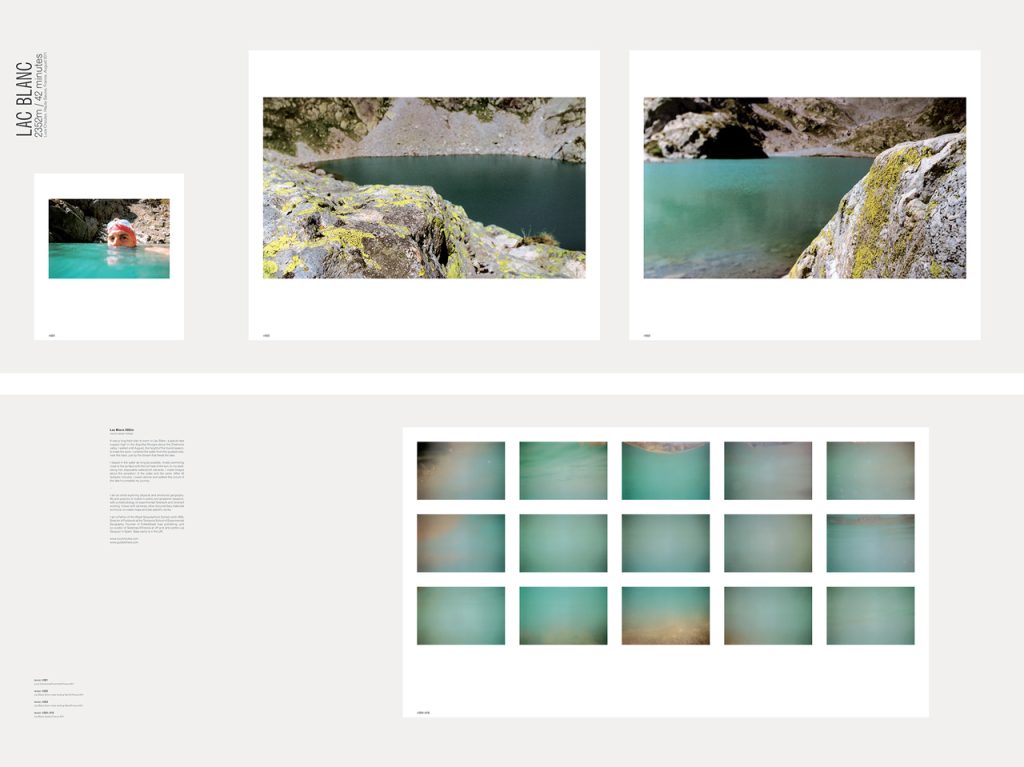
Luce Choules. An expedition-based artist working primarily in the UK, France, and Spain, Luce uses fieldwork methods to pursue an in-depth geographic study of the landscape, communicating her discoveries through a variety of photographs, maps, books, and performance lectures. She is a Fellow of the Royal Geographical Society; founder of The Temporal School of Experimental Geography; has previously worked on mapping projects with Arts Catalyst, The Photographer’s Gallery and Turner Contemporary; and has been commissioned by several cultural organizations, including Burton Art Gallery, Ironbridge Gorge Museums and Centre Regional de la Photographie Nord–Pas-de-Calais, to develop projects affecting local communities and landscape.
An excerpt from Luce’s proposal:
The value of landscapes lies not in what we can take from them but what they have to give to us; in pristine and remote landscapes, we are our pristine and remote selves – we are not separate from nature, we are nature.
Rabbit Island, ‘itself an unsettled and undivided space’, provides an opportunity to investigate new geographic methodologies and artistic taxonomies. From the unique wilderness environment, I will consider how a remote landform could create meaning for a post-contemporary cultural imagination. Can an artist-led expedition discover new routes that establish the emotional significance of wilderness? What narratives can contemporary art practice add to a remapping of landscape?
[While in residence] a series of fieldwork surveys, written observations and photographic data gathered from the island will be used to compile an experimental guidebook. In using the format of a guidebook, I want to test how a poetic sensing of landscape can reimagine navigation, way finding and exploration. Can a book be a pathway? What are the emotional features of mapping? How can we move closer to landscape – can we be landscape?
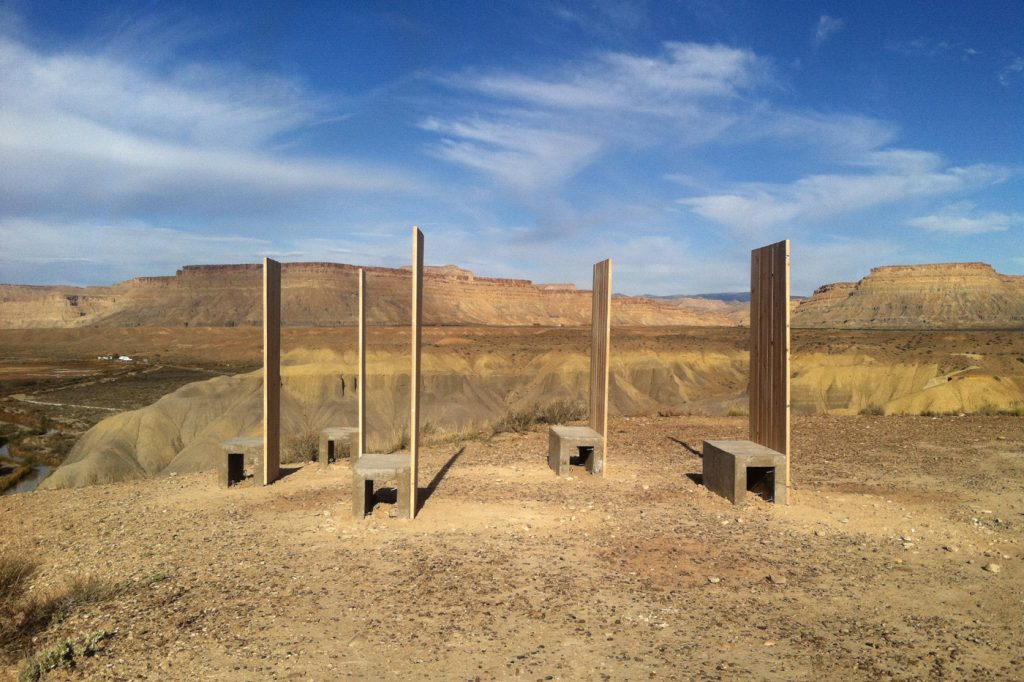
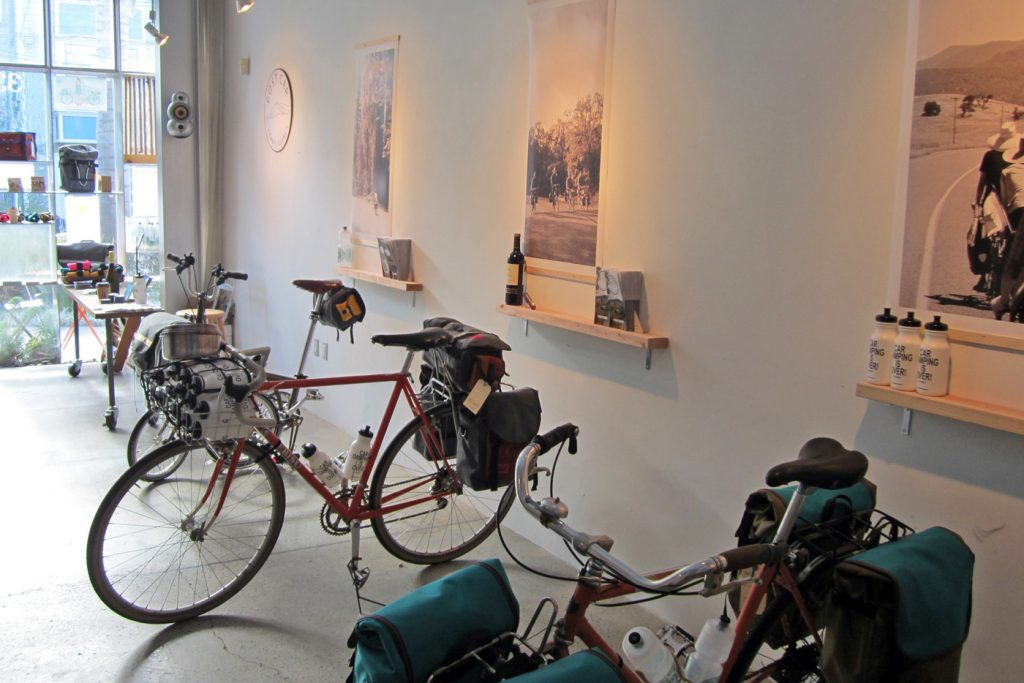
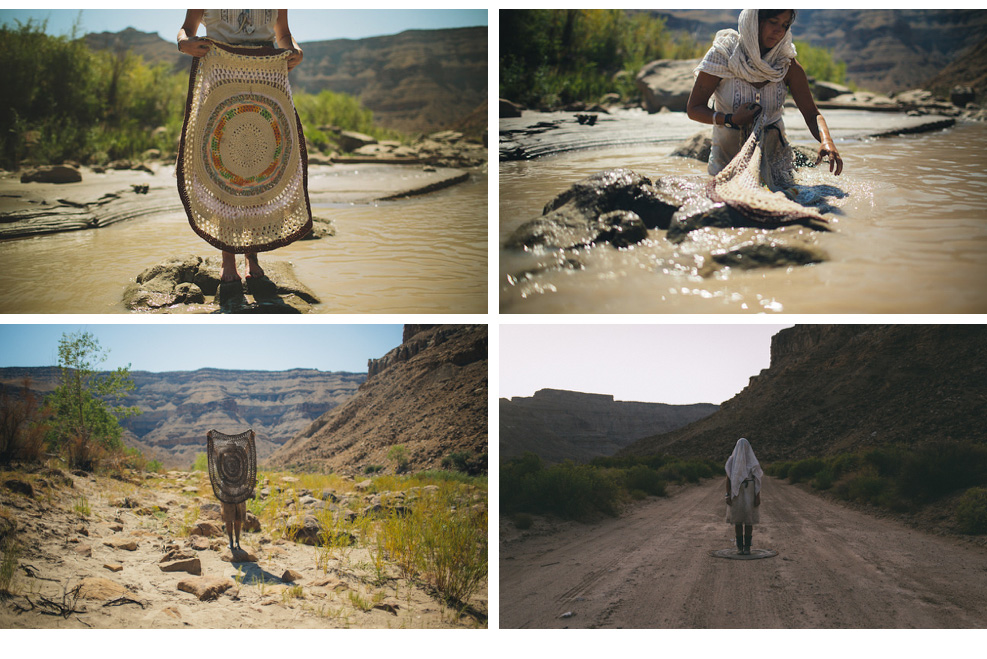
Jack Forinash, Kelly Gregory, and Mary Rothlisberger. A collaborative team consisting of interdisciplinary artist Rothlisberger (Palouse, Washington), and architects Forinash (Green River, Utah) and Gregory (Oakland, California). Mary was a recent visiting artist at the IA MFA program at Sierra Nevada College and the Arts and Rural Environments Field School at the University of Colorado. Jack is a founding member and principal of the Epicenter: a housing, community development, and arts platform in rural Utah. Kelly works at David Baker Architects in San Francisco and has initiated several socially and ecologically-focused projects under her own Roving Studio. She currently lives on a sailboat.
Excerpts from the group’s artist statement and proposal:
Our background in community-engaged art and conscientious architecture merges thoughtful and deliberate research with radical creative action. The collaborative working process includes careful dialogue with the built, natural and social environments we are situated within. Each project connects with its surroundings and encourages social cohesion and considered action. Previously, our practices overlapped in rural Utah, where we have worked creating social systems and architectural interventions for a small town on the edge of the San Rafael Swell. We welcome the opportunity to shift perspective from the vast American West to Rabbit Island, a microcosm of our rapidly evolving world.
With existing technology, we’re training ourselves to see cities and islands from above, still and removed, abstractions in soft consistent colors. But when an island inhales, so does a shoreline exhale; these internal and sentient landscapes can be brought back to the life with the right set of tools. Re-contextualizing and sharing a story of place is ever-crucial because investment in landscape is the key to better stewardship of our living earth environment.
Buoys track weather, humidity, pressure, and wind, every 20 minutes. We can be human buoys. Our collaborative process of looking, listening, and translating will be represented so that someone else can root themselves into that ever-present moment of flux and feeling. From our research, we will produce a series of new living portraits of this place. Ideas include: bathymetric and topographic technical drawings through the island, stopping not at the water’s edge but continuing until a new extent is discovered; water depth measurements using rope segments; anti-data based in experience and feelings; drawings of the lakebed from exploratory diving; an island-sized drawing recording the minute changes in water level over a full day; circumambiations of the island from water; and maybe even a call-in hotline that dials a person-perspective (instead of a buoy). Like a landscape, our practice can shift, erode, accumulate and accommodate the shape of more mindful futures.
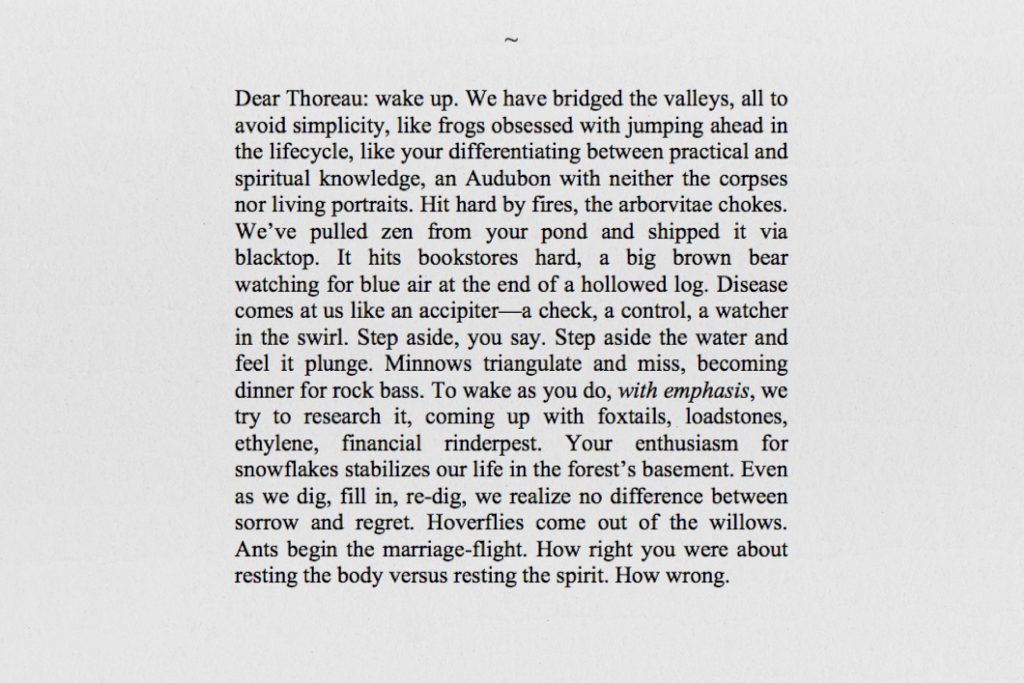
Frank Daniel Rzicznek. A poet based in Bowling Green, Ohio, is the author of two poetry collections and four chapbooks of poetry. Daniel’s work has appeared in The Kenyon Review, The New Republic, Boston Review, Orion, Gray’s Sporting Journal, and many other venues.
Excerpts from Daniel’s artist statement and proposal:
My work seeks to conflate and confuse natural, manmade, and mental environments to better delineate and challenge the divisions between each. Drawing from waking and dreaming observations, overheard speech, and textual material, my work hopes to speak/sing about humanity’s place in “nature” (my definition of which is ever-expanding) in the past, present and future, while synthesizing that nature with human history and consciousness. One belief my work frequently operates on is that a thought is just as real as an action. A fantasy and a memory can be on equal footing, and the chemical process behind imaginative thought is just as relevant as the physical atoms of the brain and the body. The result is a naturalist strain of surrealism that seeks to use image and metaphor to underline the minute-to-minute responsibilities of being human in a world at peril.
Seven years ago I began a long poem called “Leafmold.” Planned as a series of 365 interlocking pieces, one primary goal of the project is to conflate and confuse natural, manmade, and mental environments to better delineate and challenge the divisions between each. The poem draws from waking and dreaming observations, overheard speech, and textual material. (Some texts that have been reclaimed into pieces of “Leafmold” include the 1965 Audubon Nature Encyclopedia, a Cabela’s catalog, the complete lyrics of the Grateful Dead, and The Cantos of Ezra Pound to name just a few.) Using forms of narrative, epistle, and collage, I want “Leafmold” to speak/sing about humanity’s place in “nature” (my definition of which is ever-expanding) in the past, present and future, while synthesizing that nature with human history and consciousness. If offered a residency on Rabbit Island, my goal would be to compose pieces of “Leafmold” in as many microenvironments of the island as possible, including the waters of Lake Superior.
The work produced during my residency would function as a micro-manuscript within the larger 365 page work, one I would hope to complete and publish before the full project sees publication. The opportunity to work in the environs provided by the residency strikes me as completely unique. Not insignificant is the residency’s emphasis on the natural world and mankind’s dangerous, beautiful, tenuous place in it, an emphasis that I feel resonates deeply with the work I’m currently producing.

Walter van Broekhuizen. A multi-disciplinary artist from the Netherlands, working primarily in sculpture and installations. Walter attended the Rijksakademie in Amsterdam. Since the mid-90′s his work has reflected the current human condition, often with regards to nature, using different mediums to remodel our perception of landscape.
Excerpts from Walter’s artist statement and proposal:
I address our abandonment of the wild, and how, despite it, we continue to listen to the vociferations of the wilderness we have abandoned. We find ourselves continually asking: what kind of a relationship do we have with nature? What is wilderness? Is there any wilderness left? It’s my belief that imagination, combined with a surrendering to and a fascination with nature, has the power to preserve our world.
“There are enough champions of civilization,” said Henry David Thoreau in his defense of the wild. The ‘civilized’ might argue that there are enough champions of wilderness. It’s a tug-of-war constantly in play as the world evolves into a place at once more civilized than ever, while abandoning the wild to become even wilder (though less understood). But despite our abandonment of the wild, an instinct remains within us; an undeniable call to raw, uninhabited landscapes, whether real or philosophical.
Rabbit Island is such a landscape. It’s there that I’d like to ask: what are we to do with that call that still exists within ourselves?
On Rabbit Island, I’d like to explore complete solitude and a landscape undisturbed by human accomplishment. I come from a country that nearly 1000 years ago was neatly divided into parcels, and now has no naturally wild places left. The Dutch relationship with nature is to tame it - until a few years ago, even deadfall in forests was cleared because it was considered ‘unnatural’. And nowhere in the entire country does the possibility exist to be somewhere and see no other human being.
I feel it’s our duty to listen to that instinctual call, to pay attention, and to ask how we are changing the world. I’d like to use Rabbit Island as a sketchbook - to create and photograph a series of ethereal sketches of the things that make up the island: rocks, pine needles, shadows, driftwood, whatever is naturally at hand - in a celebration of what exists, resisting the human tendency to tear down, build up, and conquer, by exploring the contours of the island’s natural patterns. I’d use the elements of nature and the play of light to proffer a new view of our relationship with it, ultimately asking: how much of nature do we take for granted, or even completely miss, by not paying attention, by choosing to create and live in less wild spaces?
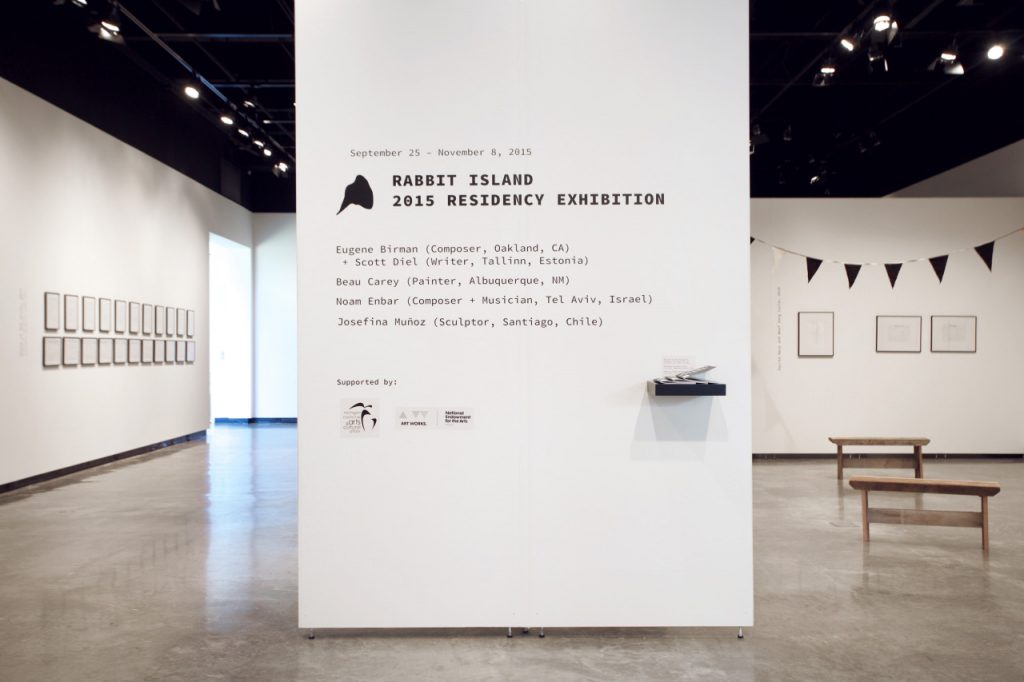
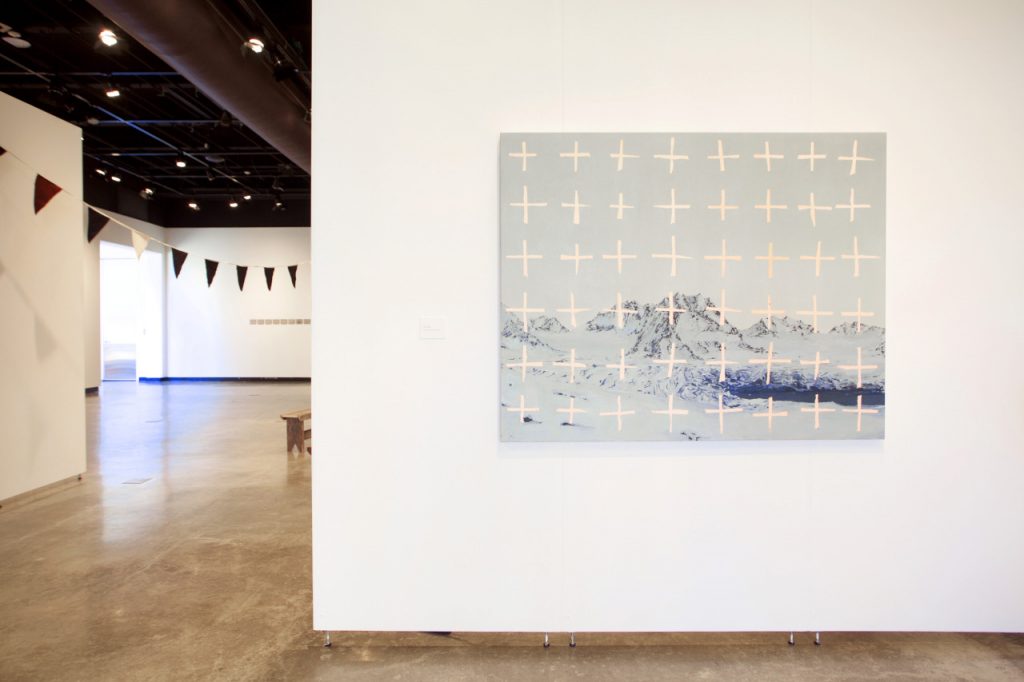
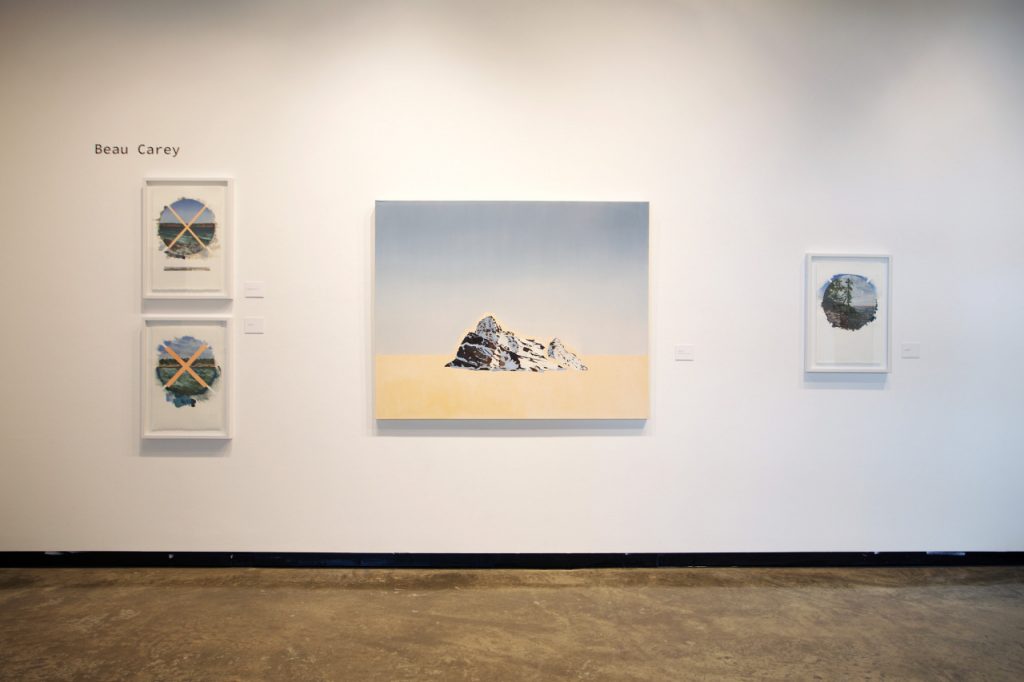
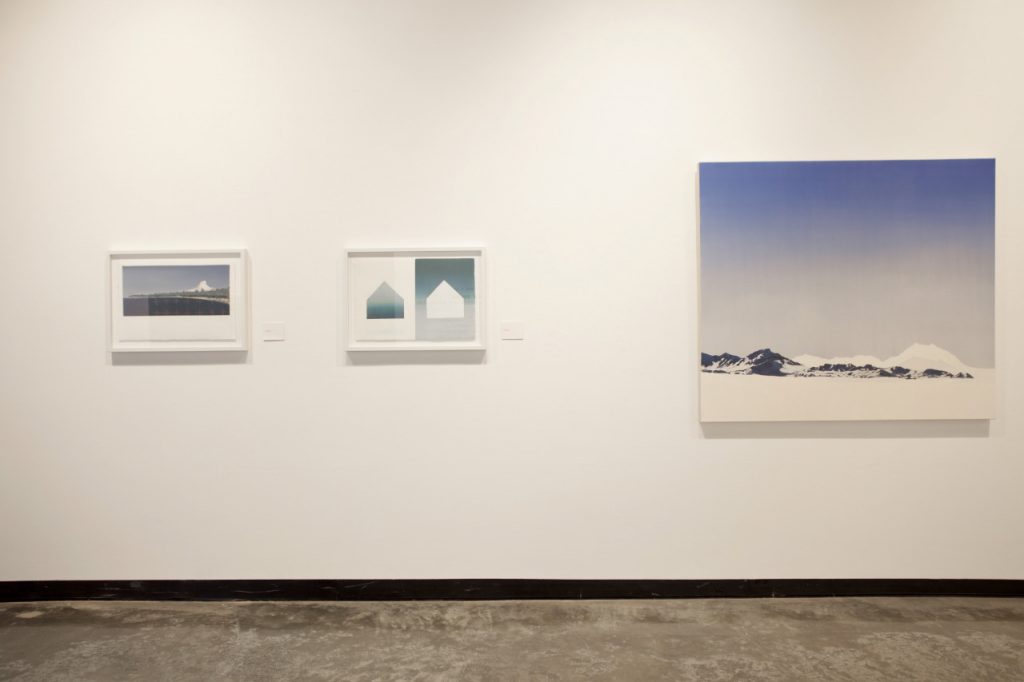
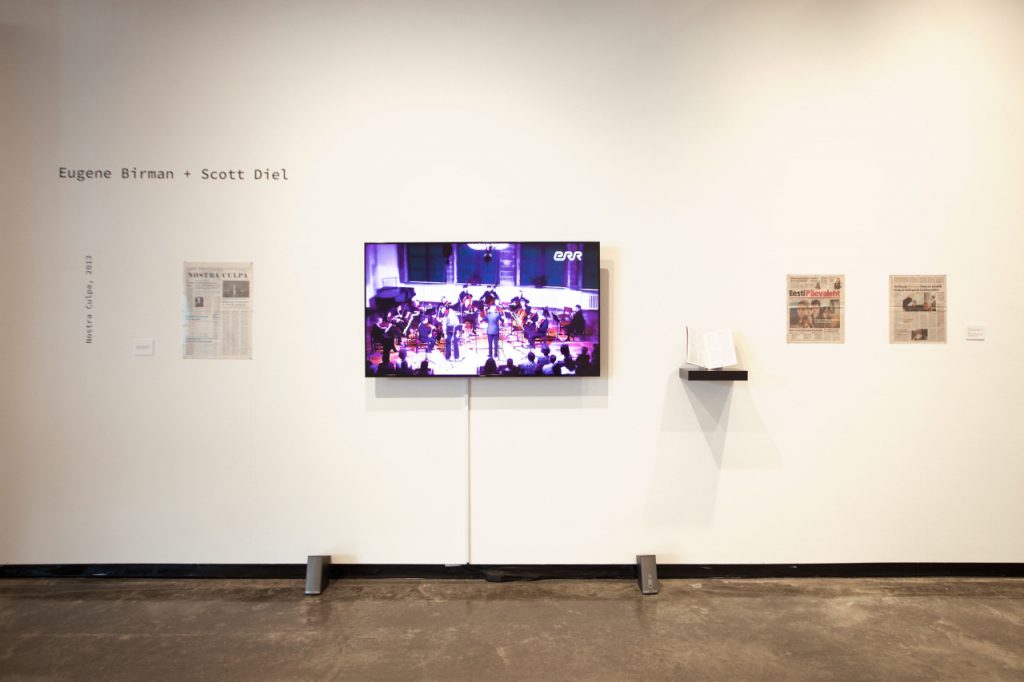
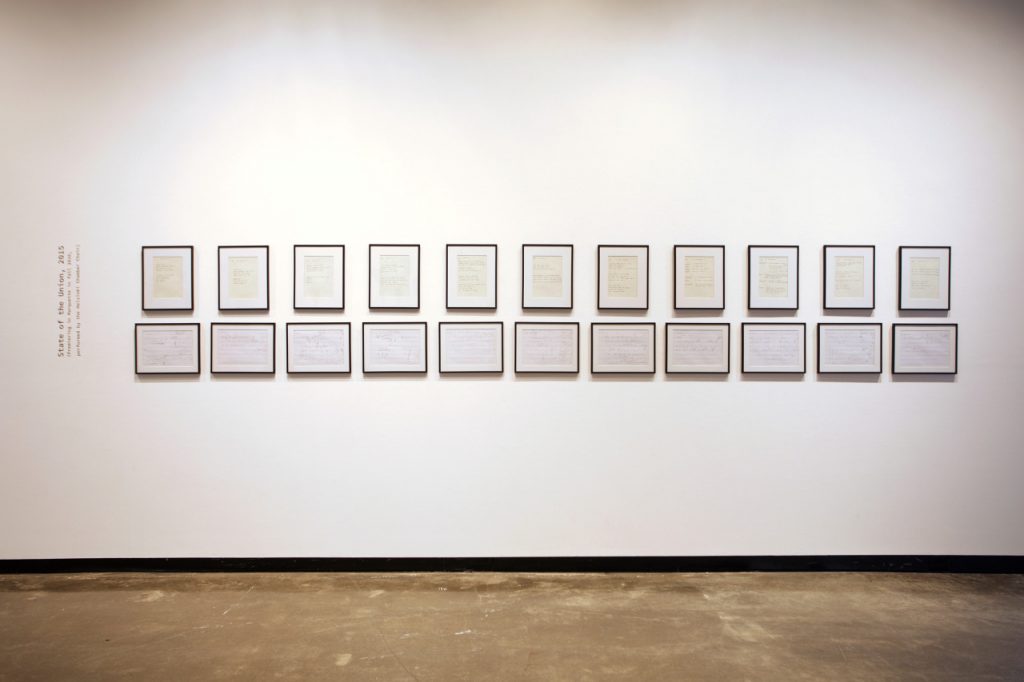
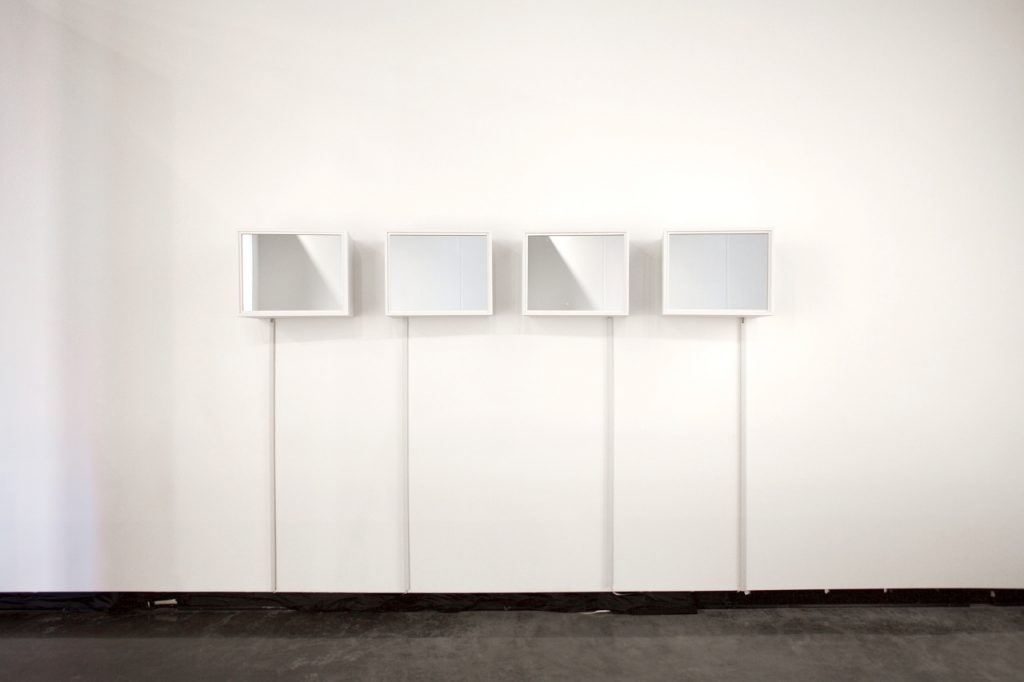
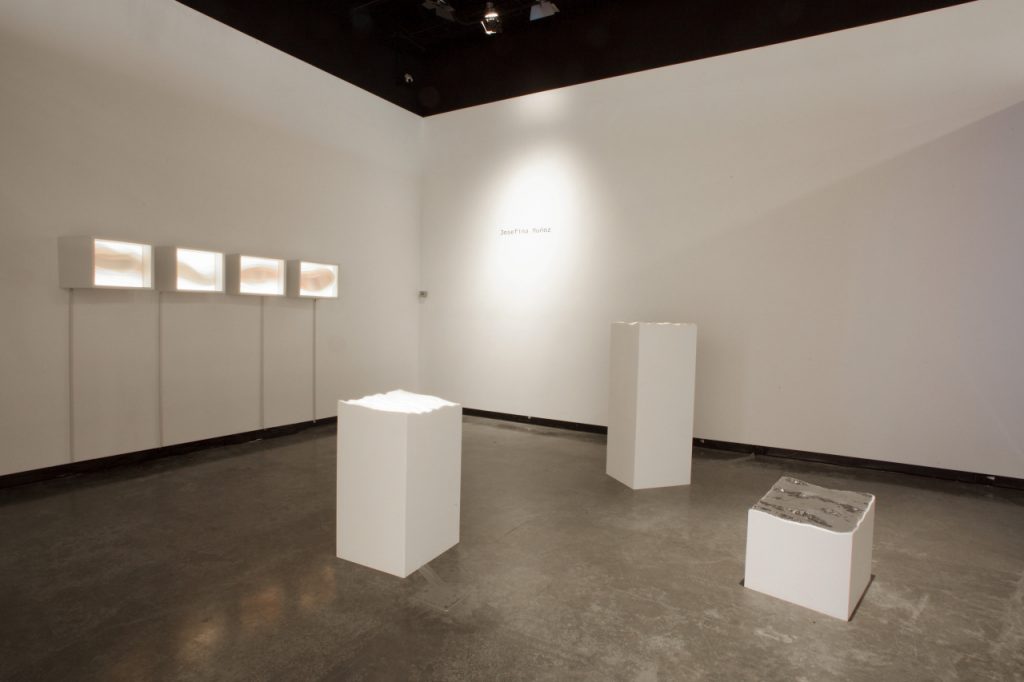
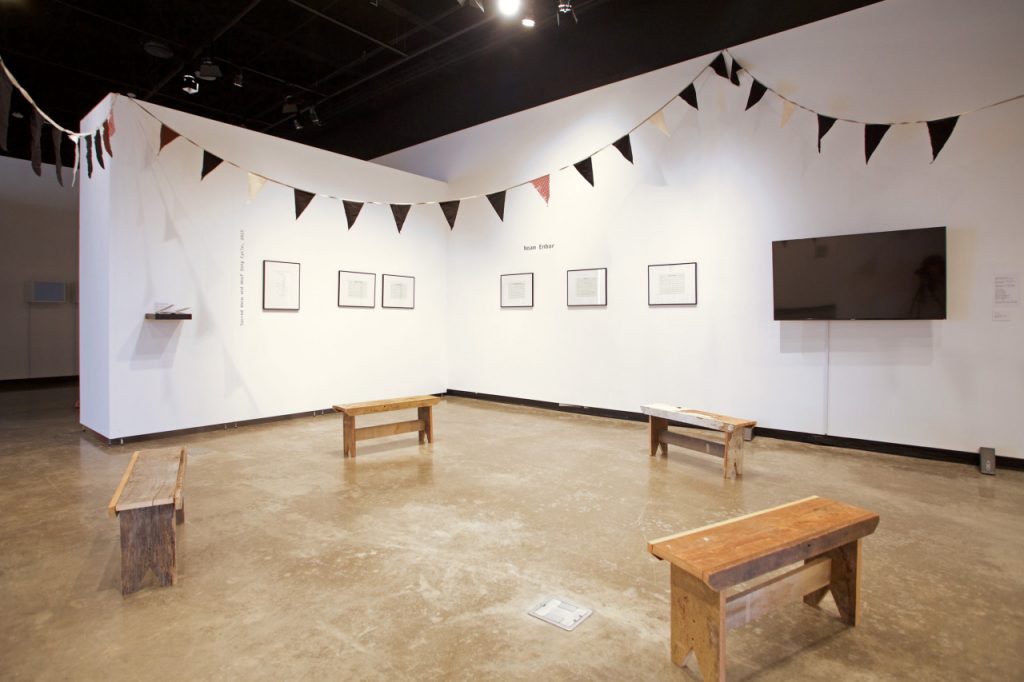
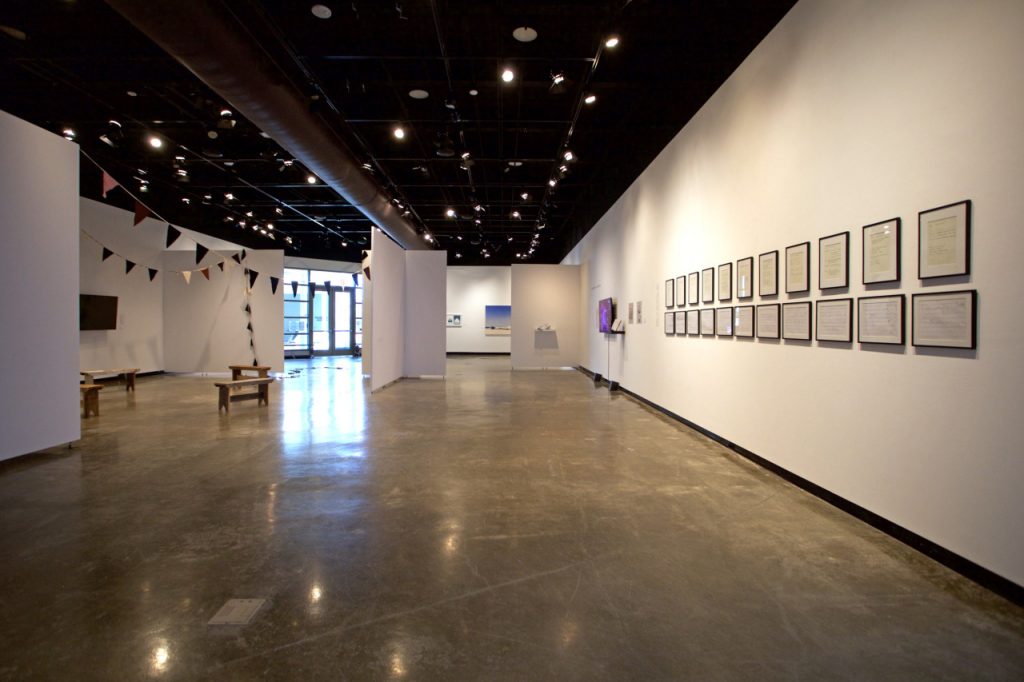
Rabbit Island 2015 Residency Exhibition
DeVos Museum of Art, Marquette, Michigan
September 25 – November 8
Josefina Munoz // Santiago, Chile // Artist in Residence 8/8/15 - 9/2/15
The following essay was written by the artist discussing her intention to live in complete isolation on Rabbit Island for several weeks during the summer of 2015. She completed this as part of a larger multi-year conceptual undertaking titled Is_Land. More about this project can be found on the her website, josefinamunoz.net.
After returning to the Keweenaw mainland, Josefina worked as a Visiting Artist at Finlandia University, in Hancock, MI, where she set up a studio and shared her creative process with students and faculty while she prepped for the annual residency exhibition.
Prior to arriving on Rabbit Island Josefina spent 10 months living in Kenya completing field research for a project and exhibition about the Turkana nomads of northwest Kenya.
+
Everything refers in fact to the differentiation which makes possible the isolation and interplay of distinct spaces. From the distinction that separates a subject from its exteriority to the distinctions that localize objects, from the home (constituted on the basis of the wall) to the journey (constituted on the basis of a geographical “elsewhere”), from the functioning of the urban network to that of the rural landscape, there is no spatiality that is not organized by the determination of frontiers. - Michael de Certeau, The Practice of Everyday Life, 1984
BORDERLESS LAND
As we migrated through the Lokwanamoru Mountains, I could understand that we were transiting through a context of rare, yet impeccable state of total isolation. Only the materiality of a few elements could reveal that we were in the 21st century: a plastic jerrycan to carry water, tier-rubber sandals, or the industrially loomed kitenge garment (1). Everything else was carefully handcrafted from wood and leather, as so were the traditions and cultural system. The scene could only be framed in a different time period; ages back.
Living with the Turkana nomads (2) allowed me to gain a new understanding of the concept of space, place, and habitability. Likewise, the remoteness of the Ilemi Triangle (3) epitomized the notion of isolation as an enduring imprint within my creative vocabulary. Somehow, while rambling through this dry and hot Sub-Saharan region I felt like an islander, in the reign of a borderless land, merely signified by twig bomas (4), utterly absent of any permanent demarcation.
INSULAR ISOLATION
The possibility of studying real insular isolation grew as an idea until it took the form of a multistep research, residency, and exhibition initiative. I have called this project Is_Land. Adhering to the premise that an island can be a geographical territory surrounded by water, but also a metaphor of sociocultural global issues, the Is_Land project focuses on a comparative analysis between the remotest inhabited island in the world, Tristan da Cunha, and other islands with unique features.
The fundamental question is to define whether a detached landmass can act as a mirror of our larger society, or if an island is an exception to the general rules that currently structure our world.
Rabbit Island, an uninhabited, pristine speck of protected land in the middle of a lake in North America, will be the first step in the process. While at Rabbit Island I will be exposed to complete solitude for around a month. The idea is to be alone. No reading, no music, no talking, no art making, no nothing. The goal is to use time exclusively to embrace the sense of solitude and to explore the island as a concept: as a space, as a place, as a metaphor.
Is_Land is an enticement to rethink the way we inhabit land and how we conceive of space – in the multifaceted sense of the concept, as defined by writers Carol Becker and Yi-Fu Tuan as a set of relations which not only refer to a material condition, but also to a complex sociocultural schema.
FRONTIERS
As I prepare to head to Rabbit Island, I can’t avoid thinking about the way spatiality is organized by frontiers (de Certeau), and how one should approach a borderline. Now, even if the assertion given by divortium aquarum seems respectable (5), I want to fully comprehend the essence of the immediate water boundary that delineates the land. The tide, the wave, and the current, all permeable topographical elements that demarcate space, are not equivalent to those imposed by humans—the wall, the fence, the line. Yet, how can we entirely apprehend these natural or human-imposed perimeters?
At the end, the examination of an island–the land, the isolation, the concept, the perimeter–is nothing more (and nothing less) than a symbol for the examination of the distinction that divorces the object or subject (island or human) from its exteriority (world). Still, as stated by English poet John Donne, and sang by many through Dennis Brown’s classic reggae tune, no man is an island (…) every man is a part of the main.
+
References
1) Kitenge: Colorful and highly patterned fabric used in East Africa.
2) The Turkana people live in northwest Kenya, averaging a population of around 900 thousand people. Traditional Turkana families nowadays live as nomadic pastoralists, migrating according to water-access necessities.
3) Ilemi Triangle: Disputed land between Kenya Ethiopia and South Sudan, covering over 5,000 square miles.
4) Boma: Swahili term used to describe branch enclosures constructed in the form of fences that conceal cattle or housing.
5) Divortium aquarum: Latin concept employed to describe the boundaries delineated by bodies of water.
RABBIT ISLAND 2015: RESIDENCY EXHIBITION
Opening Reception
September 25th 6-8pm
DeVos Art Museum (Map)
The Rabbit Island Residency, located on a remote island in Lake Superior, unofficially launched in 2010. For the last four years the DeVos Art Museum has partnered with the Residency to present public programs and exhibitions featuring the artists in residence from the current summer.
This exhibition marks the second year offering artists supported residencies from an open call for applications. Artists and designers from 31 countries working in visual art, literature, music and performance submitted over 200 applications and project ideas. The 2015 exhibition highlights the work of five artists, composers and writers selected for supported residencies this year. Each resident spent 2—4 weeks on the island between June and September. All artists will be in attendance for the show opening.
The work displayed is a mix of previous work informing the artist’s practice leading up to the residency and new work created while in residence or immediately after. Hand drawn sketches and musical compositions made on the island, in-progress drawings and paintings that were continued after the residency and lightboxes made in the few weeks before the exhibition demonstrates the powerful impact this unique residency experience has on creative practice.
Eugene Birman and Scott Diel were the first residents of 2015, arriving in June and staying for over two weeks. Birman is a Latvian-born composer based in Oakland, California. He received his M.M. in Music Composition from the Juilliard School, a B.A. in Economics from Columbia, and recently received a D.Phil in Musical Composition from Oxford University. Diel is an American-born writer based in Tallinn, Estonia, who has freelanced widely. The two have previously collaborated on several operas to critical acclaim. Their recent work, Nostra Culpa, eclectically weaves together the global debate surrounding post-financial crash austerity and a Twitter feud between a Nobel laureate columnist from the New York Times and the president of Estonia. Their unlikely inspiration results from a desire to step away from the formal opera genre and engage a wider audience with classical music that investigates contemporary issues. The exhibition will feature a continuous screening of Nostra Culpa as well as sketches from a new opera about economic disparity titled State of the Union. State of the Union will debut in Marquette in September 2016, performed by the Helsinki Chamber Choir (Helsinki, Finland).
Beau Carey, a landscape painter from Albuquerque, New Mexico, spent nearly three weeks on the island in July. Carey embeds himself in challenging environments to experience and record a sense of place, often uncovering historical and contemporary issues through his interaction with landscape. Carey has travelled extensively to remote places to pursue such practice, including the Arctic Circle in Norway and Denali National Park. He has created bodies of work set in ecologically contentious open spaces such as the Rocky Mountain Arsenal National Wildlife Refuge. Carey received an MFA from the University of New Mexico, where he currently teaches.
Israeli composer and performer Noam Enbar spent over two weeks in residence in late July. Based in Tel Aviv, Enbar formed anti-establishment band Habiluim in 2003, which became one of the main radical voices in the Israeli music scene. Enbar’s many musical projects, choral-theatrical pieces and inventive, starkly political works in collaboration with filmmaker Avi Mograbi have been performed at festivals, theaters and museums in Israel and across Europe. While in residence Enbar composed a five-piece songbook that spotlights the intersection of the political and spiritual within society. Based on writings from past Rabbit Island residents, books of poems found in the Rabbit Island library and writings by close friends, Enbar composed each song to be sung by a group of Marquette residents. The compositions are written in the style of shape notes, created in New England in the early 19th century for community singing.
Josefina Muñoz, is a multi-disciplinary artist from Santiago, Chile, was the final resident, spending nearly a month on the island in near isolation. Muñoz often works nomadically, creating pieces in and about the environments she encounters. Josefina’s seemingly disparate projects focusing on material, architecture, location, and culture come together in an overarching impulse to answer questions of global concern. Josefina’s ambitious research project Is_Land will take her to Rabbit Island, Scotland, Chiloé, and Tristan da Cunha–the most remote settled island in the world. Her goal is to create a critical body of work informed by numerous manifestation of the island concept: as space, culture, and metaphor. Muñoz received an MFA in glass from the Rhode Island School of Design.
A full color catalogue, designed by Edwin Carter, will be available in the museum. This exhibition is supported in part by an award from the Michigan Council for the Arts and Cultural Affairs and the National Endowment for the Arts.
Noam Enbar is a composer and performer from Tel Aviv, Israel. He lived and worked on Rabbit Island between July 21st and August 8th, 2015. While in residence he composed five works that will be premiered at the 2015 Rabbit Island Exhibition opening at the DeVos Art Museum in Marquette, MI, on September 25th at 7pm. These are some of his initial thoughts, which he recently sent to us.
Rabbit Island was kind to me. The Keweenaw gods made sure we had perfectly calm weather and occasionally blessed us with a pleasant breeze to drive off the big, black, malignant flies. After two days on the Island I had already composed my first piece: Come Fill the Cup, based on “Rubaiyat”, a series of rhymed quatrains by the 11th century Persian poet Omar Khayyam.

This was a great start–writing something so simple and yet artistically satisfying. It was an easy-to-sing four part anthem in the spirit of the American Sacred Harp tradition, however, based on this ancient and provocative-for-its-time sacrilegious text. I composed it in one go on the elevated tree platform located in the island’s interior which was built by artist Andrew Ranville. In the following days I composed the humorous piece “And the Astronomer Shall Dwell with the Agronomist” in my new studio, a desk and bench outside the Island’s sauna, near both water and woods.

By now, after several days in residence, I was thinking more of the possible links between my work and the actual physical circumstances surrounding me. These first two songs where great, yes, however, as I became more familiar with the environment I aspired to work with some kind of found material. I therefore started looking for texts in the Island’s library, in the journal which documented the experience of previous residents, and in the past exhibition catalogues.
It was in the 2014 exhibition catalogue that I discovered a text by Dr. Dylan A.T. Miner (Métis), exploring the colonial politics of renaming territory. The text cites the example of Rabbit Island itself being once named by Native Americans as “Ni aazhawa’am-minis” meaning “place of crossing over”. I could easily relate to this text! In my past years as punk-rocker in Israel, I wrote a song in Hebrew addressing an analogous issue: the act of re-naming Palestinian villages and streets by Zionism! This, however, was no text for an anthem or hymn. I wanted the music to express the idea using multiple layers in a less structured way, and a more provisional quality was needed with more autonomy (or better yet, the appearance of autonomy, or the questioning of the possibility of autonomy) for each of the musical layers. I therefore edited a condensed version of Dr. Miner’s text and based my composition on a past masterpiece, Paragraph 7 of the seminal piece for improvisers, “The Great Learning”, by English composer Cornelious Cardew. I kept Cardew’s ingenious format, enabling singers to select with each new word their own pitch based on what they where hearing at that very moment. I used Dr. Miner’s text instead of the original and added some visual representations of suggested ornaments the singers could use.

In my very last day on the island I come back to this idea of “place of passage”. I wanted to draw to a close my time on the island in a ritualistic way, and to celebrate both my own symbolic and literal crossing over. Returning to the tree platform, I staged a private rite, accompanied by music played with a harmonica that I found in the camp kitchen. So, here’s a recording made that day, in the forest. It’s quite long, and perhaps rather personal, but hopefully it conveys something of graceful feelings deriving from rare moments of solitude.
SoundCloud: Noam Enbar - Rite of Crossing Over
Portrait Photo Credit: Ports Bishop
